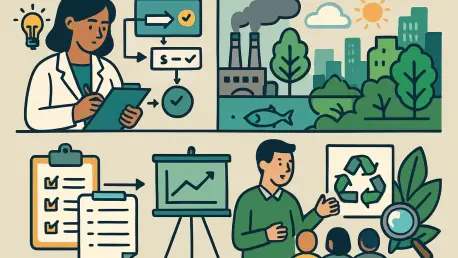Imagine a world where the very systems designed to heal are inadvertently harming the planet, contributing to a cycle of environmental degradation that threatens human health itself. In the United States, the healthcare sector alone accounts for 9-10% of greenhouse gas emissions, a staggering figure that underscores a pressing paradox. This intersection of health and environmental sustainability presents a critical challenge, one that implementation science—a field dedicated to translating research into real-world practice—can uniquely address. The purpose of this FAQ article is to explore how implementation science can drive sustainable practices in healthcare and beyond, enhancing environmental health as a cornerstone of human well-being. Readers can expect to find answers to key questions about the connection between these fields, the challenges faced, and the actionable strategies available, all grounded in evidence and practical insights.
This discussion aims to break down complex ideas into clear, digestible explanations, highlighting why environmental sustainability must be integrated into health interventions. By addressing common queries, the goal is to provide guidance for professionals, policymakers, and stakeholders interested in leveraging scientific methods to combat climate change impacts on health. The scope covers the interconnectedness of human and environmental health, the healthcare sector’s environmental footprint, and the pivotal role implementation science can play in bridging these domains.
Key Questions on Implementation Science and Environmental Health
What Is Implementation Science and Why Does It Matter for Environmental Health?
Implementation science focuses on methods to integrate research findings and evidence-based practices into everyday settings, ensuring that health interventions are effective in real-world scenarios. Its relevance to environmental health lies in the urgent need to address climate change and degradation, which directly impact human well-being through issues like air pollution and extreme weather events. As environmental challenges intensify, this field offers structured approaches to adopt sustainable practices swiftly and efficiently across sectors, particularly in healthcare.
The importance of this discipline becomes evident when considering the slow uptake of green initiatives despite clear evidence of their benefits. By studying barriers and facilitators to change, implementation science can help design strategies that make sustainability a core component of health systems. This ensures that efforts to improve health do not come at the expense of the planet, creating a balanced approach to long-term wellness.
How Are Human, Animal, and Environmental Health Interconnected?
The concept of the One Health Model emphasizes that the health of humans, animals, and the environment is deeply linked, forming a triad that must be addressed holistically. Endorsed by global bodies like the World Health Organization and the Centers for Disease Control and Prevention, this framework highlights how human activities, such as industrial expansion, affect ecosystems and animal populations, ultimately circling back to impact human health. For example, deforestation can increase zoonotic disease transmission, where pathogens jump from animals to humans due to habitat disruption.
Understanding this interconnectedness is crucial for designing health interventions that do not inadvertently harm other domains. Implementation science can apply this model by ensuring that solutions for human health also consider ecological balance, preventing scenarios where short-term medical gains lead to long-term environmental losses. This integrated perspective is essential for sustainable progress in combating health crises driven by climate shifts.
How Does Environmental Degradation Impact Human Health?
Environmental degradation affects human health in two primary ways: by worsening existing conditions and by introducing new health threats in unexpected regions. Climate-driven events like heatwaves, floods, and wildfires intensify respiratory issues, such as asthma, due to increased exposure to pollutants like wildfire smoke. Additionally, changing temperatures and precipitation patterns expand the range of vector-borne diseases, including malaria, into areas previously unaffected, posing novel challenges to unprepared communities.
Beyond direct health impacts, environmental changes disrupt healthcare delivery itself, as seen when natural disasters damage infrastructure or cut off access to medical services. These disruptions often compound during overlapping crises, such as pandemics coinciding with extreme weather, amplifying vulnerability. Implementation science can help by prioritizing adaptive strategies that mitigate these risks, ensuring health systems remain resilient amid environmental stressors.
What Role Does the Healthcare Sector Play in Environmental Harm?
Despite its mission to heal, the healthcare sector significantly contributes to environmental harm, accounting for a substantial portion of greenhouse gas emissions in the U.S. Hospitals, outpatient services, and pharmaceutical production are major sources, alongside excessive waste generation, with plastics making up about 60% of hospital discards. Much of this waste is improperly managed, leading to higher emissions and potential health risks from biohazardous materials.
Specific practices, such as the use of metered-dose inhalers for respiratory conditions, exemplify the issue, as these devices contain hydrofluorocarbons with high global warming potential. Addressing this footprint requires targeted interventions, and implementation science can facilitate the shift to alternatives like dry powder inhalers by identifying adoption barriers and designing effective rollout plans. This dual focus on health and sustainability is vital to break the cycle of harm.
Why Is the Implementation of Sustainability Interventions So Slow?
Even with growing awareness of environmental issues, the adoption of sustainability interventions in healthcare remains inconsistent and delayed. Initiatives like the U.S. Department of Health and Human Services Health Sector Climate Pledge encourage emission reductions, yet reporting and action vary widely across facilities. Systemic barriers, including misaligned financial incentives and competing priorities in patient care, often hinder progress, as immediate health needs overshadow long-term ecological goals.
Variability in adoption is evident in practices like replacing high-impact inhalers or reducing surgical waste, where success rates differ significantly by region or institution. Implementation science offers a pathway forward by analyzing these inconsistencies, developing tailored dissemination strategies, and aligning sustainability with existing health objectives to ensure broader uptake without compromising care quality.
How Can Implementation Science Promote Environmental Sustainability?
Implementation science holds immense potential to accelerate sustainable practices by applying its expertise in translating evidence into actionable change. This field can integrate environmental outcomes into the health intervention pipeline, from innovation identification to impact realization, ensuring that sustainability is not an afterthought but a core metric. Tools like the Greenhouse Gas Equivalencies Calculator and Life Cycle Assessments provide measurable ways to assess environmental impacts alongside health benefits.
Moreover, this discipline can adapt interventions to local contexts, support the phasing out of wasteful practices, and foster collaboration with environmental scientists to create comprehensive solutions. By focusing on determinants of successful implementation, such as stakeholder buy-in and resource availability, it becomes possible to scale green initiatives effectively, balancing human health needs with planetary protection over time.
Summary of Key Insights
This exploration reveals several critical insights about the role of implementation science in enhancing environmental health. The interconnected nature of human, animal, and environmental health, as framed by the One Health Model, underscores the need for holistic interventions. Environmental degradation poses direct threats to well-being through intensified health issues and disrupted care, while the healthcare sector itself exacerbates these problems through significant emissions and waste.
Challenges in implementing sustainability measures, such as inconsistent adoption and systemic barriers, highlight the urgency of structured approaches, which implementation science is well-equipped to provide. By prioritizing environmental outcomes, adapting strategies, and leveraging measurement tools, this field can bridge critical gaps. For those seeking deeper knowledge, resources from organizations like Practice Greenhealth or frameworks from global health bodies offer valuable starting points for further exploration.
Final Thoughts
Reflecting on the discussions held, it becomes clear that the urgency to merge environmental sustainability with health interventions has never been more pressing. This journey reveals actionable pathways through implementation science, which has the power to transform challenges into opportunities for systemic change. Looking ahead, stakeholders are encouraged to consider integrating sustainability metrics into their health initiatives, collaborating across disciplines to design resilient systems. Small steps, such as piloting green practices in supportive contexts or advocating for policy incentives, can build momentum toward broader impact. The focus now shifts to practical application—how might these insights shape specific actions in local healthcare settings or personal professional practices?









